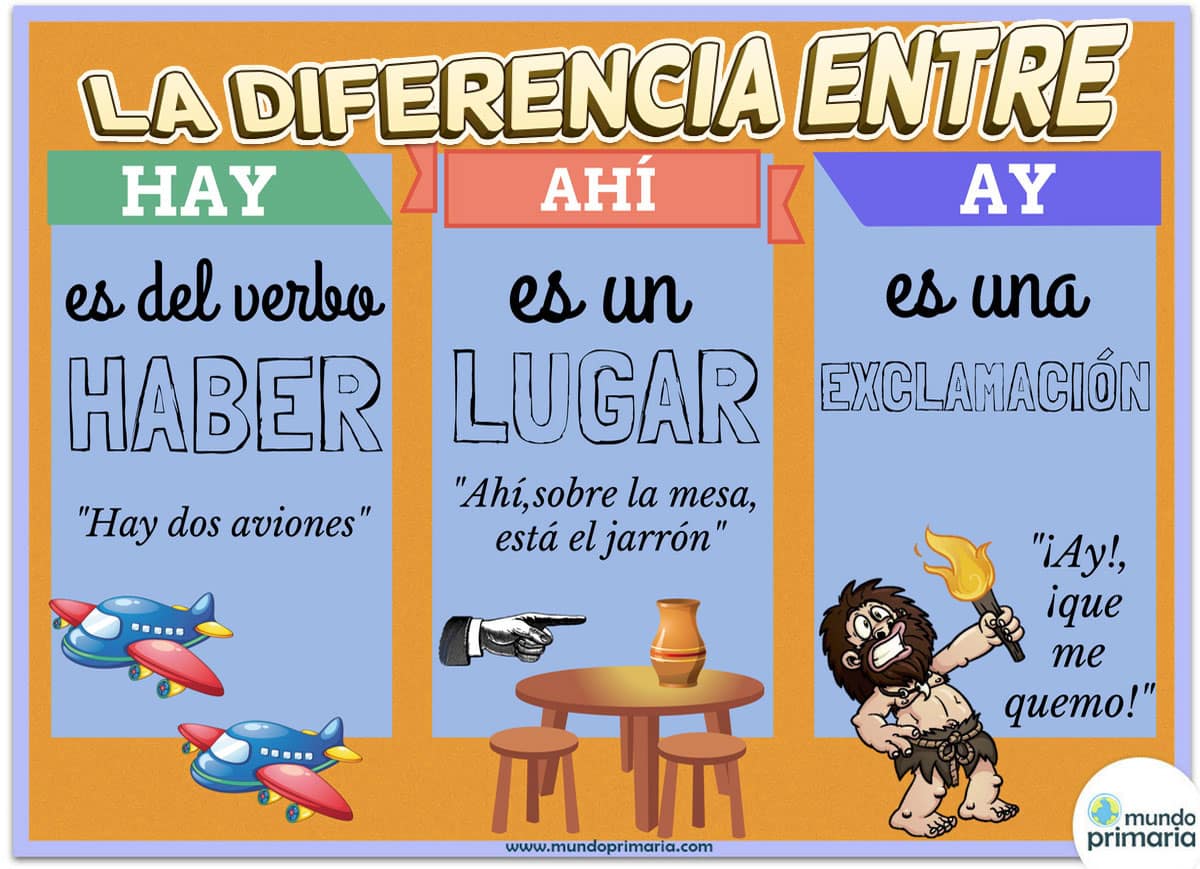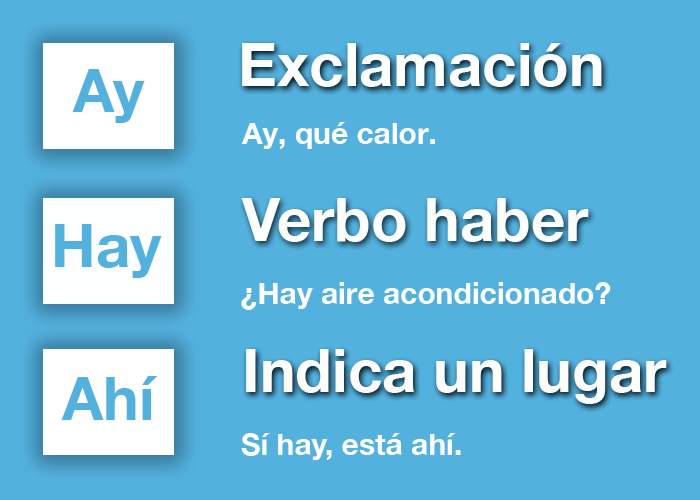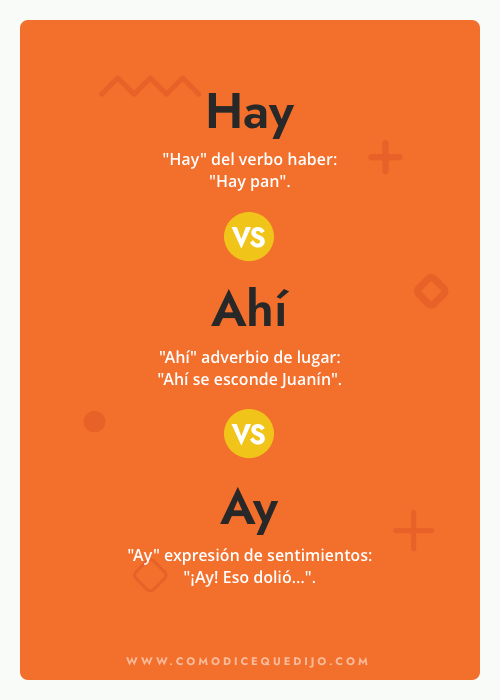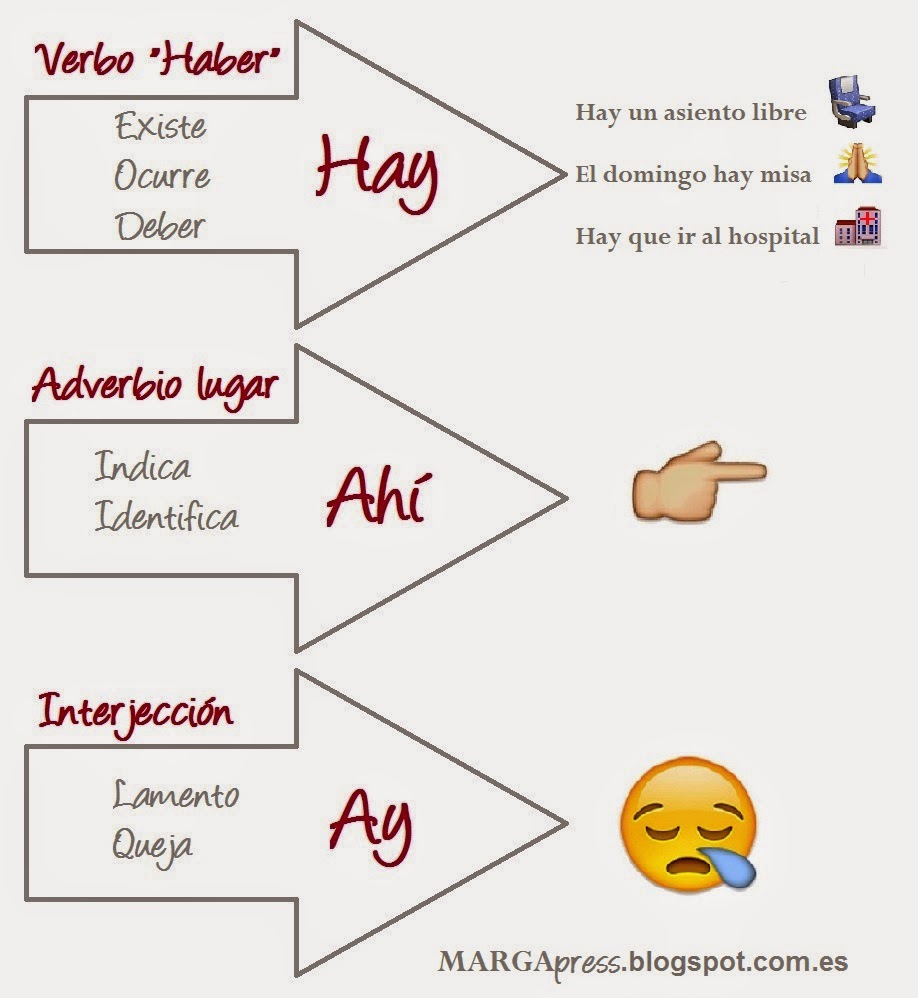
Ay Hay Ahí Ortografía, Reglas ortograficas, Centros de aprendizaje
Their meaning is different, their spelling is different, and yet, they sound the same. What are they? The Spanish words ¡ay!, hay, and ahí. ¡Ay! and ¡ahí! ca.

Las diferencias entre hay, ay y ahí La página del español
Ahí is an adverb of place, like allí and aquí. Ay is an interjection used generally as an exclamation (with corresponding exclamation marks [ ¡ !]), indicating surprise or pain. Hay and ay are pronounced the same but there is more emphasis on ay because of the exclamation: ¡ay! Ahí is not pronounced the same as hay and ay.

Hay,ahí,ay Spanish Grammar, Spanish Language, Foreign Language, Vocab
Hay, Ay o Ahí. Hay es el verbo haber conjugado en su forma impersonal; ay es una interjección que puede expresar pena o temor, mientras que ahí es un adverbio de lugar, equivalente a 'en ese lugar'. Tanto hay como ay son palabras homófonas, que suenan igual, mientras que ahí es una palabra aguda, y, en este sentido, se diferencia de.

hay,ahí,ay Tenspanish
'Hay' is the impersonal form of the verb haber, therefore, it has many uses.However, one of the most common ones is to express existence. In this context, 'hay' is the direct translation of the English expression 'there is' or 'there are'.. Hay muchos gatos en la calle There are many cats on the street. Finally, 'ahí' and 'allí' are adverbs of spatial position or.

Diferencias entre Ay, Hay y Ahí (Significado y comparación) Cuadro
Qué: Cómo utilizar y escribir correctamente 'hay', 'ahí' y 'ay'. ¿Es 'hay', 'ahí' o 'ay' la expresión correcta? ' Hay ', ' ahí ' y ' ay ' representan uno de los más populares quebraderos de cabeza que los hispanohablantes enfrentamos a menudo. Especialmente en las escuelas. Por eso, desde Estandarte.com damos una breve explicación y.

Diferencia entre Hay, Ahí y Ay? En la siguiente imagen te lo aclaramos
Hay es una forma del verbo haber: «allí hay muchos árboles». Ahí es un adverbio: «déjalo ahí, sobre la mesa». Ay es una interjección que indica dolor o temor: «¡ay de mí!».

Infografía educativa sobre las diferencias entre Hay, ahí y ¡ay
La palabra ahí, escrita así con h intercalada y con tilde en la i, es un adverbio de lugar y como su nombre indica señala una posición o un lugar. Ahí está María con su bicicleta. Mira el delfín ha saltado por ahí. Como podéis ver en estas dos frases la palabra ahí nos indica, nos señala, un lugar. Donde están María y el delfín.

TOMi.digital Uso del hay, ahí , ¡ay! Reglas ortográficas!
Ay.Se trata de una interjección que expresa diferentes estados de ánimo, por lo general dolor, queja o aflicción. Por ejemplo: ¡Ay, jamás pensé que esto terminaría así! Ahí.Es un adverbio de lugar que indica "en ese sitio". Por ejemplo: Dejé las cosas ahí, pero ya no están. Hay.Es el verbo "haber" conjugado en presente del modo indicativo, y se trata de una forma impersonal.

Diferencia entre Hay Ahí ¡Ay! Educacion integral, Ortografia
Nov 11, 2022. LITTLE VALLEY — A Cattaraugus County grand jury has handed up a 10-count indictment against a Little Genesee man in the Sept. 3 death of an Olean teen in Portville. Skyler Hess, 20.

Que Diferencia Hay Entre Hay Ay Y Ahi Esta Diferencia
Hay in Spanish: Form of the verb "haber", which means that something exists in reality or figuratively: e.g. Hay días en los que hace mucho calor. (There are days when it is very hot.) Me dijo ella que hay más papel higiénico - (She told me that there is more toilet paper) Ahí in spanish:

diferenciaentreayhayyahiparaestudiantesdeespanol
¡Ay!, hay, ahí. Are you having trouble to learn them?Learn Spanish expressions in 60 seconds!! 🔥 Join our 5 Day Spanish Masterclass here: https://www.lingom.

Hayayahi
Diferencias entre hay, ahí y ay 1. '¡Ay!' La palabra 'ay' sin hache corresponde a una interjección que se utiliza para expresar diversos estados de ánimo, como por ejemplo aflicción o.

Hay, Ahí o Ay Cómo se escribe y diferencias ¿Cómo dice que dijo?
Introducción. Las palabras hay, ay y ahí se escriben y se pronuncian de manera muy parecida pero tienen significados totalmente distintos. Esta explicación comparada te ayudará a comprender la diferencia que existe entre ellas de manera definitiva. En la sección de ejercicios puedes poner a prueba tus habilidades gramaticales y afianzar así tus conocimientos.

Ortografía Hay, ahí o ay Aula PT
Hay is a verb that expresses existence, similar to the English phrase "there is/are.". On the other hand, ahí is an adverb that refers to a place far away from the speaker, similar to the English word "there.". Meanwhile, ay is an interjection that can express a wide range of emotions, such as surprise, pain, or annoyance.

MARGA PRESS Hay, ahí, ay
Hay indicates existence, ahí and allí are adverbs used to convey location, and ay is an interjection that expresses feelings or emotions. When it comes to pronunciation, hay, ay, ahí, and allí are stressed in different vowels. Ay and hay are pronounced identically, in one syllable with the stress on the letter a.

¿Hay, ahí o ay? Las reglas de ortografía. Vídeos educativos para niños
HAY, AHÍ and AY are three Spanish words that sound exactly the same, but they are very different from each other, even belong to different grammatical categories. HAY, AHÍ vs ¡AY! examples. 1. HAY (there is, there are) is an impersonal form of the verb haber, used to indicate the existence of something. ¿No hay nadie en aquí? (There's no.